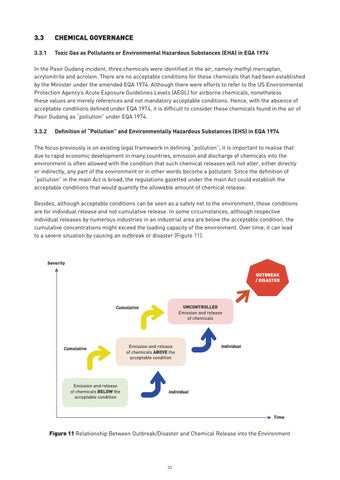3.3
CHEMICAL GOVERNANCE
3.3.1 Toxic Gas as Pollutants or Environmental Hazardous Substances (EHA) in EQA 1974 In the Pasir Gudang incident, three chemicals were identified in the air, namely methyl mercaptan, acrylonitrile and acrolein. There are no acceptable conditions for these chemicals that had been established by the Minister under the amended EQA 1974. Although there were efforts to refer to the US Environmental Protection Agency’s Acute Exposure Guidelines Levels (AEGL) for airborne chemicals, nonetheless these values are merely references and not mandatory acceptable conditions. Hence, with the absence of acceptable conditions defined under EQA 1974, it is difficult to consider these chemicals found in the air of Pasir Gudang as “pollution” under EQA 1974. 3.3.2 Definition of “Pollution” and Environmentally Hazardous Substances (EHS) in EQA 1974 The focus previously is on existing legal framework in defining “pollution”, it is important to realise that due to rapid economic development in many countries, emission and discharge of chemicals into the environment is often allowed with the condition that such chemical releases will not alter, either directly or indirectly, any part of the environment or in other words become a pollutant. Since the definition of “pollution” in the main Act is broad, the regulations gazetted under the main Act could establish the acceptable conditions that would quantify the allowable amount of chemical release. Besides, although acceptable conditions can be seen as a safety net to the environment, these conditions are for individual release and not cumulative release. In some circumstances, although respective individual releases by numerous industries in an industrial area are below the acceptable condition, the cumulative concentrations might exceed the loading capacity of the environment. Over time, it can lead to a severe situation by causing an outbreak or disaster (Figure 11).
Severity OUTBREAK / DISASTER
UNCONTROLLED Emission and release of chemicals
Cumulative
Cumulative
Emission and release of chemicals BELOW the acceptable condition
Emission and release of chemicals ABOVE the acceptable condition
Individual
Individual
Time
Figure 11 Relationship Between Outbreak/Disaster and Chemical Release into the Environment
33




